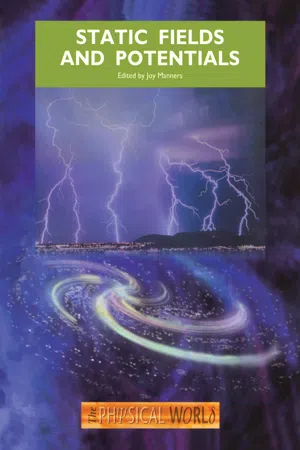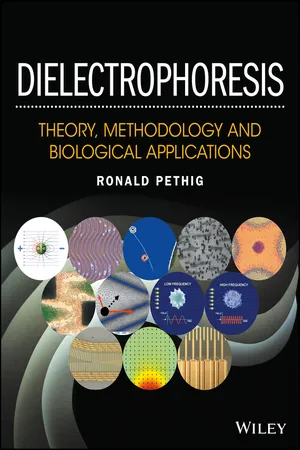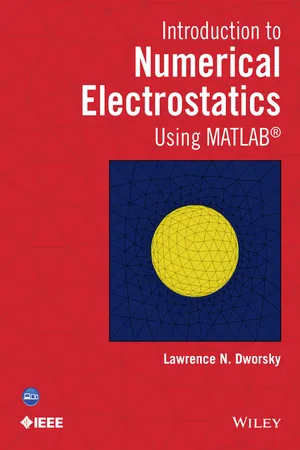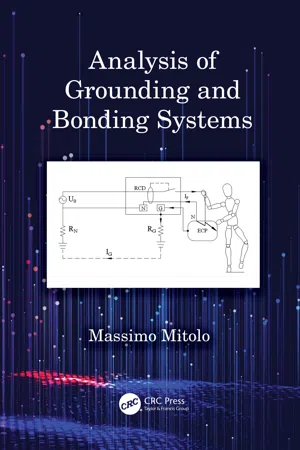Physics
Equipotential Surface
An equipotential surface is a surface in a region of space where every point on the surface has the same electric potential. In other words, no work is required to move a charge along an equipotential surface. In physics, equipotential surfaces are used to visualize and analyze electric fields and gravitational fields.
Written by Perlego with AI-assistance
Related key terms
Related key terms
1 of 4
Related key terms
1 of 3
6 Key excerpts on "Equipotential Surface"
- eBook - ePub
- Joy Manners(Author)
- 2020(Publication Date)
- CRC Press(Publisher)
V = 0 at infinity).Figure 2.13 The Equipotential Surfaces around a point charge are spheres. Note the increasing separation of the spheres with increasing distance from the charge.Question 2.13 What can you say about the relationship between the spacing of the Equipotential Surfaces in Figure 2.13 and the magnitude of the electric field? From what you know about the direction of the electric field associated with a point charge, what can you say about the relative orientations of the Equipotential Surfaces and the electric field lines for a point charge? ■In this example, the radial electric field is perpendicular to the spherical Equipotential Surfaces. But is it generally true that field lines cut equipotentials at right angles? To answer this question, consider two adjacent points A and B on the same equipotential (Figure 2.14a ) and suppose the direction from A to B determines the direction of the x-axis. By definition, A and B must be at the same potential. Since ΔVis therefore equal to zero, Equation 2.18(tells us that there can be no component of ℰ in the direction joining the two points. If the electric field exists at all in this region, then in order to have zero x-component, the field must be at right angles to the x-direction. Hence:)ℰ x= −Δ V/Δ xElectric field vectors always cut Equipotential Surfaces at right angles.Figure 2.14 (a) Since A and B are at the same potential, there can be no force component (and therefore no electric field component) along the line between them. Hence the electric field vector ℰ - eBook - ePub
Molecular Driving Forces
Statistical Thermodynamics in Biology, Chemistry, Physics, and Nanoscience
- Ken Dill, Sarina Bromberg(Authors)
- 2010(Publication Date)
- Garland Science(Publisher)
To illustrate the idea of electrostatic potential, consider a distribution of charges in a plane. Positive charges tend to move toward regions of negative electrostatic potential. Negative charges spontaneously move toward regions of positive electrostatic potential.Think of the contours of an electrostatic potential surface in the same way you think of the contours of altitude on a geological map. A geological map plots lines of constant altitude z(x,y) as a function of north–south and east–west coordinates (x,y). Such maps describe the gravitational potential energy field. If you walk from coordinate (x1 , y1 ) to coordinate (x2 , y2 ), your altitude increases from z1 to z2 . In this analogy, the positions of the mountains are fixed and the mass that you carry up the mountain is called the test particle. Multiplying that mass by the altitude difference gives the gravitational energy change: mass × gravitational acceleration constant × height. We do the same calculation here with charges and electrostatic potentials, rather than with masses and altitudes. No work is required to move charges along contours of constant electrostatic potential, just as no gravitational work is done in walking along level paths on a hillside. For a point charge, a surface of constant electrostatic potential is any sphere of radius r centered on the point. It requires no work to move a test charge anywhere on that sphere (see Figure 21.2 ). The electric field E is always perpendicular to an Equipotential Surface.Figure 21.2 The electrostatic potential is constant at distance r from a point charge. Lines of equipotential are circles in two dimensions. Broken lines indicate the direction of force and the field E.The Equipotential Surfaces Around Two Positive Point ChargesFigure 21.3 Lines of equal electrostatic potential around two positive point charges.The dashed lines in Figure 21.3 show the electric field E in the (x,y) plane due to two charges of the same sign: q at x = -ℓ/2, and q at x = +ℓ/2. The x axis is an axis of symmetry of this electric field and charge constellation. The solid curves indicate the intersection of the plane of the page and the Equipotential Surfaces. If you rotate the solid curves about the x axis, out of the plane of the page, you generate the full three-dimensional Equipotential Surfaces. The Equipotential Surfaces become more nearly perfect spheres as their distance from the charges increases. Therefore, at a distance far away from the point charges, you can view the electrostatic potential as though it were due to a single point charge equal to 2q at x - eBook - ePub
Dielectrophoresis
Theory, Methodology and Biological Applications
- Ronald R. Pethig(Author)
- 2017(Publication Date)
- Wiley(Publisher)
Equipotential Surfaces and electric field lines are always mutually orthogonal.Figure 4.6A cross-section is shown of the Equipotential Surfaces (−8 V, −6 V, −4 V and −2 V) around a spherical electrode of radius 20 μm, electrified to a potential of −10 V with respect to a zero reference at infinity. The radial field lines E intersect the spherical Equipotential Surfaces at right angles.Example 4.6 Relationship between Electrode Surface Charge Density and the Potential Difference between Parallel ElectrodesDerive an expression that relates the charge density per unit area on parallel electrodes, of the form shown in Figure 4.2 , to potential difference between the electrodes. Assume that the width of the electrodes is much greater than the distance d between them, so that the field generated between them can be considered uniform.Solution 4.6 The work Wx done by the field E in moving a test charge q from the cathode to a location x above the cathode is given by:From Box 4.1 this work done is equal to the negative of the change in potential energy U, so that:where Uc is the potential at the cathode. The potential V at any location is the potential energy per unit charge, so that:When the distance x is equal to the distance d between the cathode and the anode, Vx is the potential Va at the anode, so that:The electric field between parallel electrodes is thus equal to the potential difference between the electrodes divided by the distance between them:(4.24)From Equation (3.21) of Chapter 3, the field in the dielectric between two parallel electrodes is:where σ is the charge per unit area on the anode (or −σ on the cathode). From Equation (4.24 - Lawrence N. Dworsky(Author)
- 2014(Publication Date)
- Wiley-IEEE Press(Publisher)
1.28 ) is a scalar equation, which is almost always easier to work with than is a vector equation. Also, once the voltage is known, it is a straightforward job to calculate the field. Consequently, we will concentrate on finding voltages and then (if necessary) finding the field, not the other way around.For the single-point charge of equation (1.28 ), we already know that the field lines point radially outward (from the charge), going to infinity. Figure 1.9 . shows surfaces of constant potential, known as Equipotential Surfaces or more commonly equipotentials. These surfaces cross the field lines normally and in this situation are spheres.Electric field lines and Equipotential Surfaces about a point charge.FIGURE 1.9If, instead of a single charge q, we have a collection of (discrete) charges, we must replace equation (1.28 ) by the sum of the contributions of all the charges, and a is replaced by the distances from each of the charges (xi ,yi ,zi ) to the measurement point p = (xp ,yp ,zp ). In other words,(1.29)and then(1.30)The gradient [equation (1.26 )] operating on V produces en electric field vector whose direction is the same as that of the maximum change in V. Since the direction of maximum change from an equipotential contour is always normal to the contour, the electric field lines will always be normal to the equipotential contours. Figure 1.10 is essentially a repeat of Figure 1.1- eBook - ePub
- Massimo Mitolo(Author)
- 2020(Publication Date)
- CRC Press(Publisher)
2The Ground Potential
2.1 The Ground Potential
To investigate the nature of ground potentials, we can use an elementary ground-electrode: a conductive hemisphere of radius r 0 with the center located on the surface of the earth. We imagine applying a potential difference between two such hemispheres placed at a distance d from each other much greater than their radii. The first hemisphere will leak the current into the soil, whereas the second one will receive it. We assume a uniform and isotropic soil, composed of a single layer of material, whose resistivity ρ is constant and invariant with respect to the direction.As a result of the applied voltage across the hemispheres, a ground current will circulate through the earth. It should be noted that the current will not leave the “transmitting” electrode along a shortest path in the direction of the “receiving” electrode through a “preferred” area of its surface. The current, instead, will “diffuse” from the electrode’s surface along radial lines and keep this pattern for a large volume of soil. At a greater distance from the first electrode, the circulation pattern will adjust so that the ground current will enter the second electrode in the same radial fashion (Figure 2.1 ).FIGURE 2.1 Radial current lines and Equipotential Surfaces of hemispherical electrodes (V 1 > V 2 ).Electric potentials are associated with the circulation of ground currents. Such potentials are constant over the surface of the hemisphere, as well as along all hemispherical cross-sections of the soil, which are defined as Equipotential Surfaces (Figure 2.1 ). Their intersections with the soil plane determine the earth potentials over the soil itself. The radial ground current lines are perpendicular to the Equipotential Surfaces.The above described behavior of the hemispherical electrode may be applied to all ground-electrodes, regardless of their shape. The lines of the ground current will have a pattern strictly related to the electrode’s shape only in its immediate surrounding volume of earth; as the ground current exits this volume, the lines will assume a radial pattern. This is the reason why the study of the hemispherical electrode, which is not used in practical applications, is the basis to model the ground potentials of any other differently shaped electrode. - eBook - ePub
Engineering of Submicron Particles
Fundamental Concepts and Models
- Jayanta Chakraborty(Author)
- 2019(Publication Date)
- Wiley(Publisher)
Gauss law says that a spherically symmetric surface of uniform charge density may be considered as a net point charge located at the centre of a sphere. This situation applies near the surface where no counter‐ion or electrolyte is present. Let us denote the net charge of the sphere as. Hence, the electric field just outside the surface will be The corresponding potential is given by: Using this boundary condition and remembering that, we get Finally, If the potential at surface is denoted by, Also is very small according to our previous assumption. Therefore, the exponential term is close to unity. This gives Note that is not small at all values of. This relates the surface potential to the total amount of surface charge for a spherical particle. Next we will relate the charge on the particle to its velocity. Since the particle is effectively an macro‐ion, the development in the previous section can be used and the mobility of the particle becomes Combining: Hence, the surface potential () can be obtained by measuring the velocity of the particle under a known electric field. It should be noted that the surface potential measured by the above method is somewhat lower than the true surface potential [5], [6] because of the finite ion size at surface. Hence, this potential is called the (zeta) potential and is considered as an approximate measure of the true surface potential. 4.6.2 Surface Potential When In the previous case most of the counter‐ions experience the free stream velocity and are swept away from the particles. However, if the EDL is very thin compared to the particle size (see Figure 4.8), the opposite occurs: most of the ions remain attached to the particle. The fluid velocity is small near the surface and hence the viscous force is not enough to sweep away most of the counter‐ions
Index pages curate the most relevant extracts from our library of academic textbooks. They’ve been created using an in-house natural language model (NLM), each adding context and meaning to key research topics.
Explore more topic indexes
Explore more topic indexes
1 of 6
Explore more topic indexes
1 of 4





